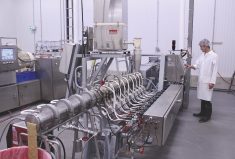Behind the scenes in Canada’s food-processing industry, countless entrepreneurs are conjuring up new business opportunities by making more efficient use of our crops, including through improved processing and the use of previously wasted portions stock.
Watching over and assisting many of these developers is Roberta Irving, who is in charge of business development at the Portage la Prairie Food Development Centre.
With her comprehensive background as a dietitian, plus her sales and marketing experience in food production and the food industry, Irving has been the go-to person in the field for the past six years.
Read Also

Building a farm legacy that outlasts you
A farm’s legacy isn’t just about the land; it’s also about the values and the impact that continue long after the current owner has stepped away.
Although it has clients from across North America and the world, the centre is part of Manitoba Agriculture and its primary mandate is to help farmers and food companies develop new uses and markets for the province’s commodities.
“It’s interesting because of trends,” says Irving. “We’ll see ebbs and flows.”
Small company prepares for major growth
The Manitoba company Canadian Prairie Garden Puree Products Inc. (CGP), is gearing up for a major growth spurt, with the introduction of some further specialized equipment that will allow it to process pulses.
The company is led by its founder and chief operating office, Kelly Beaulieu, an agronomist by trade with a background in R&D and agriculture.

Beaulieu started with the fact that from 30 to 60 per cent of the vegetables grown in Manitoba get discarded in the field — a reality that did not sit well with her.
“The reason for this was that they were visually imperfect — the wrong size, had a little blemish, discoloured, or just something really insignificant to the quality of the product itself,” says Beaulieu. “Farmers are forced by the retail market to sort that product into only blemish-free ones — the perfect-size ones.”
But this means that a third to almost two-thirds of their crops get plowed down or fed to cattle, with little if any return to the inputs and effort that the farmer put into growing them.
Beaulieu felt producers would jump at a secondary revenue stream for this “imperfect” product. She began by looking into setting up a quick-freeze plant that could be used around the world, providing a market option for crops conceivably worth billions of dollars.
But Beaulieu found that the freeze concept was impractical, so she continued her research, which eventually led her to focus on steam infusion technology, developed specifically for processing purées and pulse crops.
“We have a game changer in the industry, because of this development,” says Beaulieu.
“In Manitoba, something like nine million pounds of carrots are discarded in the field. But that can now change. We can now peel them, clean them up, remove blemishes with the steam peeler, put them through a grinder and our steam infusion cooking process, and — in nine seconds — they are fully cooked to sterile.
“From the time the product is cleaned and put into our system, it’s approximately two minutes of time in our equipment. Then, it goes into our pouch — a bag-in-box pouch that is flexible — so, it replaces tin cans and the like. The purée and the pouch are shelf stable. It will last and retain qualities and nutrients for two years at room temperature. That’s the product that we’ve developed.”
Thanks to the rapid cooking and cooling, the technology retains all the freshness and nutritional qualities.
Recently, Beaulieu and company have begun working with protein-rich pulse crops, says Beaulieu. “Our equipment is well suited to process pulses, and also does things like hummus starters. So, a hummus manufacturer could buy our drums of hummus starter, the chickpea purée, and it’s ready to use.
“Our competitors in the industry for that product have to bring in product from offshore. It comes in big tin cans, so they have to open every tin can and discard the can. It’s packed in brine, so it’s salty. Then, they have to grind and work with that product.
“The alternative is our product. With that, all they need to do is slit the bag open, then it’s immediately usable. The bag is even recyclable.”
Now, CGP also has a navy bean product that is being put into a myriad different formats, Beaulieu says. “This is a great way for CGP to provide some value-added products instead of selling raw foods right here in Manitoba.”
There is no shortage of potential end-users for the products — from any large kitchen to food manufacturers — with 33 different types of CGP purées. The majority of the purées is vegetables and pulses, but the company also works with saskatoons.

Buying from local farmers
“We like to buy local, as there is a lot of variety here, a lot of opportunity, and it’s better for the environment to package something where it’s grown,” says Beaulieu. “We have this in mind with everything we do — reducing the environmental footprint of our plant.”
While CGP has bought products from Ontario and a few from the U.S., the vast majority of what the company processes is grown locally.
With a current capacity of about 27 million kgs annually, the plant runs at about 3,400 kg per hour, despite a footprint of less than 7,000 sq. ft. and low water and power needs.
“That was one of the things I put into place when I built the plant,” says Beaulieu. “It had to meet environmentally friendly standards. I wanted to decrease our waste, to look at it from a level of not only how farmers could reduce their waste streams, but also at the consumer level. If people are buying a frozen product, five to seven per cent of that product is immediately wasted in the plant… Not in our plant. With our product, there’s no waste.”
Beaulieu sees huge need for the technology ahead. “Our product removes the seasonality supply of freshness and nutrition,” she says. “In 2050, we’re going to have something like 9.5 billion people on the planet. We have to find the means to better utilize the food resources we currently have. Technology advancements in food processing are going to be one of the methods that will give us the opportunity to utilize and better distribute all the food we already have.”
Growers are very interested in working with CGP, as the company offers another revenue stream for product they would normally discard or have very low opportunity to sell.
“We actually have been holding back on what we can pack, because we have too many farmers coming to us,” says Beaulieu. “But, I don’t discourage the farmers. We want them all when we open the second plant. Our dream has always been to have several of these plants and to utilize all the waste product out there.”
Clean labels
But the big trend now is what’s called the clean label. For instance, the centre has done intensive work on the use of flax to replace gum-type binders, taking advantage of the adhesive strength of flax, and there’s work underway to replace nitrates with celery powder.
For example, four years ago, energy bars were really popular, and Irving says the centre helped clients develop products for that market. Some were pulse based. Others were pea and lentil based.
“These developers are always asking for clean labels, and they want this because that’s what consumers want,” Irving says.
“Consumers are looking for labels they can easily read and know what all the ingredients are.”
The challenge is that while to consumers this might seem a simple — you might almost say a “natural” — process, it can actually be incredibly complex.
Each ingredient in their favourite products is there for a critical function, Irving points out. And, without these critical ingredients, the product simply would not taste, feel or store the same.
Thus the hunt is on to find better replacements, which might be better because, for instance, an ingredient might contribute to more than one function, in the way that salt, for instance, is both a preservative and a taste enhancer, and sugar can be both a sweetener and a binder.
“For the last couple of years now, we’ve been doing more with plant proteins or plant fibres,” says Irving. “There’s really an appetite for plant-based products, as some people are trying to go more without meat. Historically, if you had a non-dairy product or you wanted a meat substitute, there were very poor ingredients out there as substitutes. But now, because of new technologies, plant proteins are really front and centre, being used as ingredients to create really good-tasting products.”
In the non-dairy category, almond milk is an example of a product that probably wouldn’t have been commercial in any sort of big way until now. And, in the meat substitute category, the U.S.-based company, Impossible Foods, is using a technology of plant proteins to create meat substitutes.”
Already, Impossible Foods has created a plant-based burger that acts and tastes like an authentic beef burger, including the “plant blood,” mouth feel, and sizzle you would get from a regular burger, which means their business target can be the huge audience of meat lovers, not the smaller audience of purist vegans.
Closer to home, Irving is working with Canadian pioneers in this new field, such as Manitoba Starch. “It gets clean potato water from McCain here in Portage la Prairie and extracts the starch,” explains Irving. “There is this huge trend looking at using waste products in the processing industry.”
Another company Irving has worked with is Shape Foods out of Brandon, Man., which has developed a way to make shelf-safe flax oil. “It’s developed a processing technology so its product has a 24-month shelf life, which is unheard of in the industry,” says Irving. “If you don’t open it, it would be shelf stable for 24 months. If you open it, you put it in the fridge.”
Pulses are getting attention too. “Historically, using pulses in the food industry has been difficult because of their strong smell and taste,” Irving says. “But lately there’s been more technologies developed through extraction — like taking the fibre out of peas, beans, and lentils, and using it in breads. It can even be used as a coating for chicken nuggets. We did a study here and were able to replace 50 per cent of the white flour in a chicken nugget coating with pulse flour.”
There are even bonus benefits to using pulse flour, Irving says, such as better colour, faster browning, less fat needed for cooking, and better crunch.
There are all kinds of good reasons to use pulses in other products and, with the possibility of using extraction processes, the possibilities may well be endless.
“You’re starting to see more pulses going into breads, because you can still put them in and have a light, airy texture, which is what people want in bread,” says Irving.
On the horizon, Irving envisions further use of supercritical food extraction to extract proteins and other ingredients from produce such as spinach, kale, and locally grown fruit, like sea buckthorn, some of which could be sold to high-value markets, like the cosmetic industry.















